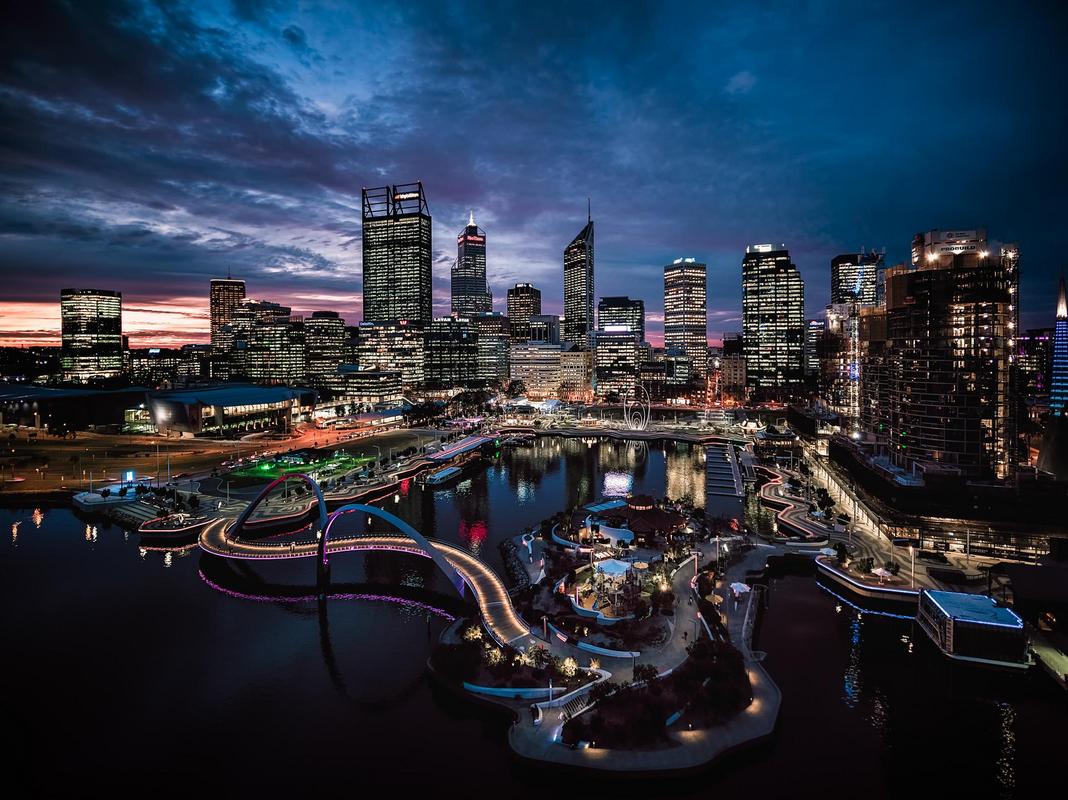Focus industries

From the resources sector to high-end agribusiness, higher education, the services sector and medical research, Australian businesses are keen to collaborate at home and abroad. With one of the world’s most educated, multicultural and multilingual workforces, and Australia’s generous tax incentives for research and development, Perth is a rapidly developing innovative research ecosystem and a thriving startup hub. It is the place to innovate.
A student city

Perth has internationally recognized universities and colleges and is consistently rated as one of the world’s most liveable cities. Being the only Australian capital city on the Indian Ocean Rim, Perth is an increasingly popular choice for overseas students.
A center for medical excellence
Perth is at the forefront of innovation in the areas of medical research and healthcare. The 28-hectare Queen Elizabeth II Medical Centre is the largest of its kind in Western Australia and is home to the Harry Perkins Institute of Medical Research which specializes in cancer research, heart and kidney disease, diabetes, neurogenetic and mitochondrial diseases.
Tourism

Perth has transformed in recent years through an unprecedented period of tourism investment. This has delivered world-class infrastructure including Perth Arena, Elizabeth Quay, Yagan Square and Optus Stadium. In the not-too-distant future, the New Museum for WA will add to the city’s attractiveness and unique offering.
The global energy city
Western Australia is blessed with an extraordinary natural endowment of mineral and petroleum, and Perth has established itself as a global energy city. Today, the city is home to a number of international resource and gas energy companies, with eight of the world’s 14 largest international energy companies having offices in Perth. Among those located in the city include ExxonMobil, PetroChina, BP, Royal Dutch Shell (Shell) and Chevron.
Total exports of petroleum from Western Australia in 2017was valued at $21.3 billion including LNG, LPG, condensate and crude oil. Western Australian LNG represented 12% of global production for 2017. Total sales of produced petroleum included $14.9b in LNG, $4.7b in crude oil and condensate and $1.7b in natural gas. Western Australia’s LNG production capacity will grow to 50 million tonnes a year by the end of 2018 when the Wheatstone, Ichthys, and Prelude projects reach full production. In April of2018 Chevron announced the expansion of the Gorgon Gas Field at a forecast expenditure of $5 billion. This project commences with the drilling of 11 new infield gas wells.
Our oil and gas industry is predominantly offshore with subsea completions the predominant production method. We have a small onshore oil and gas community with minor production. In the Perth Basin. The Australian Company AWE has been bought out by Mitsui in order to gain control of the yet to be developed Waitsia Gas Field. This is the largest gas discovery to be developed onshore Western Australia in over 30 years. In the remote Canning Basin, oil minor, Buru continues development and production of the Ungani oilfield. Buru hopes to increase production to 3,000 bbls per day while continuing to truck oil to port for export.
With the election of a new labor government late in 2017there is now a permanent ban on fracking in our South West, Perth and Peel regions and a moratorium over the rest of mainland WA while a scientific inquiry is underway. This will curtail development of new tight gas reserves onshore Western Australia and halt exploration for shale oil.
Due to the previous domestic gas reserve from offshore fields Western Australia enjoys the lowest domestic gas prices in Australia.
Retail

With predictions Perth’s population will reach 3.5 million by 2050, the city is poised to become Australia’s third largest capital. This growth is fueling significant investment in property by both the public and private sector. More than $350 million is being invested in the retail sector alone, at Raine Square, Forrest Chase and Plaza and Piccadilly Arcades.
Creativity blooms in Perth

With its laid-back but vibrant lifestyle, Perth’s creative industries are unique, nimble and thrive on both a national and international level. In music, performing arts, film, TV production, advertising, architecture, digital content and publishing, the creative sector is growing and the central city is home to some of the most creative minds in the country.
The City of Perth places a high value on attracting and retaining creative businesses within the city and supports the industry through a range of initiatives. To find out more visit invest.perth
Technology and co-working

With a well-educated, multi-cultural and multi-lingual workforce, Perth has a rapidly evolving start-up and innovation ecosystem. In 2015, there were 335 technology and active digital start-ups in Western Australia, an increase of 235% over the previous two years. There are approximately 3,000 people working in creating early-stage scalable technology start-ups and 24 supporting shared workspaces in central Perth.
Mining and Minerals
Mining contributes over $70 billion/ year to Western Australia’s $116 billion GSP. Major mineral and metals contributors by value are Iron Ore (33% of world production), Gold (6% of world production), Alumina(11% of world production) and bauxite, Nickel (8% of world production), base metals including copper, lead and zinc, tin, tantalum and lithium and mineral sands.
We produce over 50 minerals and metals from Western Australian mines including garnet, ilmenite, leucoxene, zircon and rutile.Western Australia accounted for 53% of the world’s seaborne trade in iron ore. Western Australia exported 210 tonnes of gold in 2017. We also produce globally significant volumes of rare earths, diamonds, salt, and cobalt. Approximately95,000 people are employed in the mining industry of Western Australia as of March 2018 (Total employment 1.33 million).
Agriculture
Agriculture contributes $6.8 billion of Western Australia’s $247.7 billion GSP. Half of Western Australia’s value from agriculture comes from the Wheatbelt Region. Agriculture led real growth in GSP in the State for 2016-17 with a 24% increase. By employment numbers Agriculture is the 12th largest industry sector in the State.
World-class producer
Our state’s agri-food sector is well placed to offer premium products that are sustainably and ethically produced, of known provenance and exceptional quality.
As well as being the nation’s largest grain-producing region, Western Australia is a significant producer of Australia’s meat and livestock, dairy, wool, horticulture and honey products.
WA is one of the most pest-free and disease-free agricultural production areas in the world. Strict quarantine requirements ensure this status is maintained for the benefit of local producers and consumers around the globe.
This, combined with a focus on innovation, research and development, allows the sector to meet the specific requirements of domestic and overseas customers.
Export focus
The sector places a high value on overseas markets, with agriculture being WA’s second major export industry. Our state exports up to 80 per cent of its agricultural production.
In 2015/16, WA exported an estimated $7.64 billion in agriculture and food products. The top three products exported were wheat, barley and canola.
For the past decade, about 70 per cent of the state’s agrifood exports has been destined for Asia, with China, Indonesia and Vietnam some of our largest markets.
With growing demand for premium agrifood products, especially in Asia, WA is in a good position to build on its reputation as a reliable supplier of clean, safe and high-quality food to overseas markets.
Supporting communities
The WA agriculture and food sector represents about 10 per cent of the state’s economy.
It is a significant source of employment, providing jobs for 183 600 people in 2015/16, and continues to be the lifeblood of rural and regional communities.
https://www.agric.wa.gov.au/western-australias-agriculture-and-food-sector
Contact: agrifood@agric.wa.gov.au
Energy and Environment
Western Australia is the Resource and Energy Capital of the Indo Pacific Region. We have a very positive trade balance in energy resources. Net energy production exceeds 2,400 Pj with exports exceeding 1,300 Pj. Australia is the second largest exporter of LNG in the world after Qatar and Western Australia produces more than 50% of Australian LNG. We host the world’s largest man made floating object in the Prelude FLNG vessel and the world’s largest semi submersible platform at the Ichthys gas field. We also produce and export crude oil, condensate, and yellow cake uranium. We are world leaders in Carbon Geosequestration. Coal resources are limited and used exclusively for domestic consumption primarily for the generation of electricity.
Production of electricity from wind, and solar are on the increase with abundant resources of these and ocean power available. Total rooftop solar pv generation exceeds 670 MW with over 25% of households owing at least one system. Peak electricity demand in our main grid is forecast at 4,620MW for 2018-19. Our current fuel mix for electricity generation is 50% coal 40%gas, 8.5% wind and 1.5% other including solar.
As the world turns increasingly to batteries for energy storage it turns increasingly to Western Australia for the mineral and metals resources necessary to build modern batteries. More about this under the Mining and Minerals tab.
Renewables and Smart Energy
Perth is in the South West Region of Western Australia within the largest energy grid in the State, the South West Interconnected System (SWIS). The first power plants on the SWIS were coal and were constructed by the State Government on or near the only Western Australian coal fields at Collie in the 1940’s and 1950’s. Oil competed with coal as a fuel during the 1950’s and 1960’s. Natural gas was first produced for sale from the Dongara gas field in October 1971 and resulted in the construction of the first gas pipeline in the state. The purpose was to bring natural gas from the Dongara Gas fields to Perth, the Kwinana Power Station, and Alcoa operations at Kwinana and Pinjarra. Natural gas from the offshore North-West Shelf Gas Fields was introduced into the grid in 1984 following construction of the Dampier to Bunbury natural gas pipeline.
Introduction of Renewable Energy
Australia's first commercial wind farm, Salmon Beach Wind Farm near Esperance in Western Australia operated for 15 years from 1987, but was decommissioned due to urban encroachment; it has been replaced by Ten Mile Lagoon Wind Farm and Nine Mile Beach Wind Farm.
The first commercial-scale PV power plant, the 1 MW Uterne Solar Power Station, was opened in 2011.
The second opened in 2012 at Greenough River Solar Farm Western Australia with a capacity of 10 MW.
In mid-2016 the SWIS had 21 MW of Biogas, 10MW of solar, and 478MW of wind capacity.
Currently proposed renewable power plants include an additional 312MW of solar 380MW of wind, 20MW of wave power and 80MW of proposed biomass.
Estimated peak capacity for the 2018-19 Capacity Year is 4,620 megawatts all of which is available from existing fossil fuel and renewable power plants. Over 25% of homes in Western Australia have rooftop pv systems for a total estimated capacity of over 670MW or 14.5% of peak demand.
Energy retailers on the SWIS are controlled by license from the State Government and currently limited to 3 companies for small energy users such as households, so competition is limited. Smart meters are available for a price and a new delivery contract including rates according to time of use. These are supplied with software to allow personal management of energy use. Plans including home charging of electric vehicles off peak hours and ‘green’ energy option (higher prices for renewable energy) are offered. While the green energy you buy won’t necessarily get to your home, your investment goes towards the purchase of renewable energy certificates (RECs) from Australia's own national accreditation program - Green Power.
Peer to peer power trading utilising blockchain technology is being trialed in Western Australia. Power Ledger ran their first US$27million cryptocurrency IPO in October 2017. https://web.powerledger.io/
The State’s largest gentailer is working on new edge of grid solutions based on microgrids. The State Government has approved State-owned energy generator and retailer Synergy, to enter into a joint venture with world-renowned infrastructure investment company DIF and Australian industry super fund Cbus for the development of large-scale renewables projects in Western Australia.
Under the joint venture, Synergy, DIF and Cbus have established 'Bright Energy Investments'. This group will deliver Stage Two of the Greenough River Solar Farm (GRSF2) south of Geraldton, increasing its capacity from 10MW to 40MW; as well as the refurbishment of Albany Grasmere Wind Farm.
Bright Energy Investments is also undertaking preparatory work on the development of a further proposed renewable energy project in the Warradarge Wind Farm (WWF).
ASX-listed diversified engineering and infrastructure company RCR Tomlinson has been awarded the Engineering, Construction and Procurement (EPC) for the expansion of GRSF2, with an immediate project start and targeted completion in the second quarter of 2019.
The joint venture with DIF and Cbus is an important step to ensure Synergy meets its Large-scale Renewable Energy Target (LRET) obligations under Commonwealth legislation.
Under Commonwealth legislation, the LRET scheme requires 33,000 gigawatt hours of renewable energy to be produced nationally by 2020 and those levels maintained until 2030.
